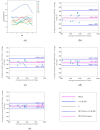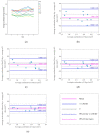How Many Days are Necessary to Represent Typical Daily Leg Movement Behavior for Infants at Risk of Developmental Disabilities?
- PMID: 32961954
- PMCID: PMC7570480
- DOI: 10.3390/s20185344
How Many Days are Necessary to Represent Typical Daily Leg Movement Behavior for Infants at Risk of Developmental Disabilities?
Abstract
Background: Movement characteristics can differentiate between infants at risk and infants with typical development. However, it is unknown how many days are needed to accurately represent typical daily behavior for infants at risk of developmental disabilities when using wearable sensors. To consider the balance between participant burden and the amount of data collected and optimizing the efficiency of data collection, our study determined (1) how many days were necessary to represent typical movement behavior for infants at risk of developmental disabilities and (2) whether movement behavior was different on weekend days and weekdays.
Methods: We used Opal wearable sensors to collect at least 5 days of 11 infants' leg movement data. The standard (average of 5 days) was compared with four methods (average of the first 1/2/3/4 days) using the Bland-Altman plots and the Spearman correlation coefficient. We also compared the data from the average of 2 weekend days to the average of the first 2 weekdays for 8 infants.
Results: The Spearman correlation coefficient comparing the average of the first 2 days of data and the standards were all above 0.7. The absolute differences between them were all below 10% of the standards. The Bland-Altman plots showed more than 90% of the data points comparing the average of 2 days and the standards fell into the limit of agreement for each variable. The absolute difference between weekend days and weekdays for the leg movement rate, duration, average acceleration, and peak acceleration was 15.2%, 1.7%, 6.8% and 6.3% of the corresponding standard, respectively.
Conclusion: Our results suggest 2 days is the optimal amount of data to represent typical daily leg movement behavior of infants at risk of developmental disabilities while minimizing participant burden. Further, leg movement behavior did not differ distinctly across weekend days and weekdays. These results provide supportive evidence for an efficient amount of data collections when using wearable sensors to evaluate movement behavior in infants at risk of developmental disabilities.
Keywords: at risk; developmental disabilities; infant; minimum wear time; wearable sensor.
Conflict of interest statement
The authors declare no conflict of interest.
Figures








Similar articles
-
Barcoding, linear and nonlinear analysis of full-day leg movements in infants with typical development and infants at risk of developmental disabilities: Cross-sectional study.Infancy. 2023 May;28(3):650-666. doi: 10.1111/infa.12537. Epub 2023 Mar 15. Infancy. 2023. PMID: 36921012 Free PMC article.
-
How Many Days Are Necessary to Represent an Infant's Typical Daily Leg Movement Behavior Using Wearable Sensors?Phys Ther. 2019 Jun 1;99(6):730-738. doi: 10.1093/ptj/pzz036. Phys Ther. 2019. PMID: 31155662 Free PMC article.
-
Immediate Effect of Positioning Devices on Infant Leg Movement Characteristics.Pediatr Phys Ther. 2016 fall;28(3):304-10. doi: 10.1097/PEP.0000000000000272. Pediatr Phys Ther. 2016. PMID: 27341579 Free PMC article.
-
Assessment of upper limb use in children with typical development and neurodevelopmental disorders by inertial sensors: a systematic review.J Neuroeng Rehabil. 2018 Nov 6;15(1):94. doi: 10.1186/s12984-018-0447-y. J Neuroeng Rehabil. 2018. PMID: 30400992 Free PMC article.
-
Quantification of the validity and reliability of sprint performance metrics computed using inertial sensors: A systematic review.Gait Posture. 2019 Sep;73:26-38. doi: 10.1016/j.gaitpost.2019.07.123. Epub 2019 Jul 2. Gait Posture. 2019. PMID: 31299501
Cited by
-
Barcoding, linear and nonlinear analysis of full-day leg movements in infants with typical development and infants at risk of developmental disabilities: Cross-sectional study.Infancy. 2023 May;28(3):650-666. doi: 10.1111/infa.12537. Epub 2023 Mar 15. Infancy. 2023. PMID: 36921012 Free PMC article.
-
Quantifying Arm and Leg Movements in 3-Month-Old Infants Using Pose Estimation: Proof of Concept.Sensors (Basel). 2024 Nov 27;24(23):7586. doi: 10.3390/s24237586. Sensors (Basel). 2024. PMID: 39686123 Free PMC article.
-
A systematic review of portable technologies for the early assessment of motor development in infants.NPJ Digit Med. 2025 Jan 27;8(1):63. doi: 10.1038/s41746-025-01450-3. NPJ Digit Med. 2025. PMID: 39870826 Free PMC article.
-
Comparison of End-to-End Neural Network Architectures and Data Augmentation Methods for Automatic Infant Motility Assessment Using Wearable Sensors.Sensors (Basel). 2023 Apr 6;23(7):3773. doi: 10.3390/s23073773. Sensors (Basel). 2023. PMID: 37050833 Free PMC article.
-
Accelerometer Thresholds for Estimating Physical Activity Intensity Levels in Infants: A Preliminary Study.Sensors (Basel). 2024 Jul 9;24(14):4436. doi: 10.3390/s24144436. Sensors (Basel). 2024. PMID: 39065833 Free PMC article.
References
-
- Zablotsky B., Black L.I., Maenner M.J., Schieve L.A., Danielson M.L., Bitsko R.H., Blumberg S.J., Kogan M.D., Boyle C.A. Prevalence and trends of developmental disabilities among children in the United States: 2009–2017. Pediatrics. 2019;144:e20190811. doi: 10.1542/peds.2019-0811. - DOI - PMC - PubMed
-
- Bultmann C., Orlikowsky T., Häusler M., Trepels-kottek S., Disselhorst-klug C., Schoberer M. Early human development spontaneous movements in the first four months of life: An accelerometric study in moderate and late preterm infants. Early Hum. Dev. 2019;130:1–9. doi: 10.1016/j.earlhumdev.2019.01.002. - DOI - PubMed
MeSH terms
Grants and funding
LinkOut - more resources
Full Text Sources
Medical

